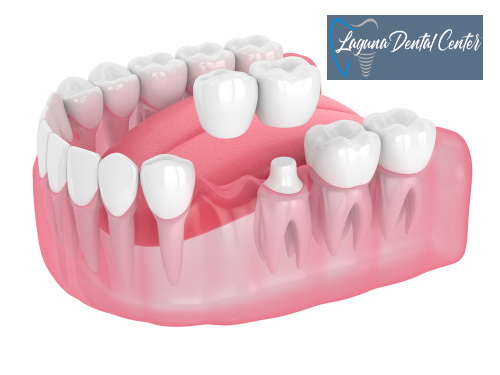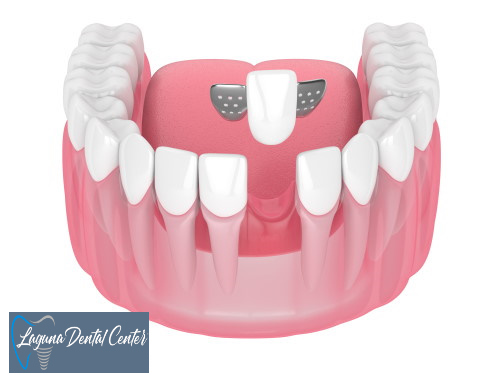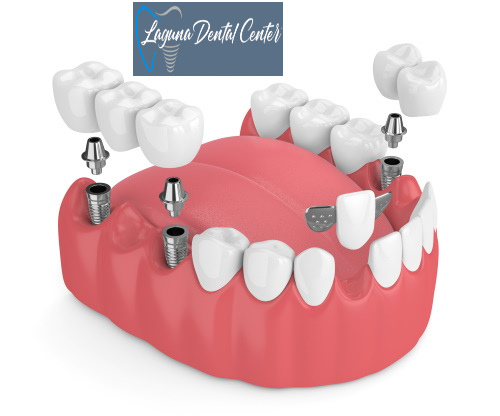Table of Contents

What are Dental Bridges?
A dental bridge is a fixed dental repair that consists of one or more false teeth in the space between two or more crowns on either side of the gap kept in place by the abutment teeth. These artificial teeth, or pontics, can be created from various materials, including gold, metals, porcelain, composite resin, or a combination.
What are the Types of Dental Bridges?
Dental bridges come in four types: conventional, cantilever, Maryland, and implant-supported.
- Traditional Bridge. In a traditional dental bridge, each abutment tooth receives a dental crown to hold the fake tooth or teeth in place. The most common form of dental bridge is a traditional bridge, which can be utilized when you still have healthy teeth on either side of the gap left by your missing tooth.
- Cantilever Bridge. A cantilever bridge is identical to a traditional dental bridge. Nonetheless, in a cantilever dental bridge, the pontic is kept in place by a dental crown affixed to only one abutment tooth. A cantilever bridge requires only one natural tooth next to the missing tooth gap.
- Maryland Dental Bridge. Like a typical bridge, a Maryland dental bridge uses two natural abutment teeth, one on each side of the gap. On the other hand, a standard bridge puts dental crowns on the abutment teeth, and a Maryland bridge uses a framework of either metal or porcelain attached to the backs of the abutment teeth. Like a standard bridge, a Maryland bridge may only be utilized if you have a natural tooth on either side of the gap produced by the missing tooth or teeth.
- Implant-supported Bridge. Dental implants, as opposed to crowns or frameworks, are used in implant-restrained bridges. One implant is surgically implanted for each lost tooth to hold the bridge in place. If one implant for each missing tooth is not viable, the bridge may have a pontic hanging between implant-supported crowns.
How do dental bridges work?
A dental bridge typically requires two dentist visits.
- Your dental bridge dentist will reshape your abutment teeth at your initial session. The enamel and dentin will be removed to make way for the crown.
- Your teeth will be photographed or digitally scanned by your professional. A dental laboratory will use the scan or model to construct a bridge, fake teeth, and crowns. To protect the exposed regions of your mouth, you’ll wear a temporary bridge until your permanent bridge is ready.
- Your dentist will remove the temporary bridge and replace it during your second visit. Your professional will inspect the bridge and make any required changes.
Make an Appointment with Dr. Ayzin at Laguna Dental Center
- FREE Dental Bridge Smile Consultation ($100 Value)
- FREE Digital X-rays, especially for Tooth Bridge ($150 Value)
- We maximize your insurance, so you pay less out of pocket.
Contact Us:
Am I a candidate for Dental Bridges?
Candidates for dental bridges will have one or more missing teeth that have either fallen out or been pulled. They must also have two strong and healthy teeth on either side of the toothless region.
- You should have generally decent oral health. Before a bridge may be put, you should not need any dental treatment done soon.
- You should have two strong teeth on each side when teeth are lacking. The supporting teeth should not require future dental care since they may become infected and lose strength over time, rendering them unsuitable for sustaining the bridge.
- You should have healthy jawbone density if you choose a bridge supported by a dental implant.
- You should be clear of gum disease; if you have gum disease, you must treat it before proceeding with the bridge surgery.
How long do dental bridges last?
Bridges have an average lifespan of 10 to 30 years. Longevity is determined by the state and health of the teeth and mouth. Your dental hygiene and how well you maintain it also impacts your life. Dental bridges, according to the University of Rochester Medical Center, can endure ten years or more with adequate care and maintenance. A dental bridge performed by a professional with the competence and abilities required to provide the best quality treatment has a better probability of success and longevity.
What are the main advantages of Dental Bridges?
- Keeps the natural face shape. Losing a tooth can damage the jawbone underneath the gap, resulting in an abnormal facial profile in the long term. Dental bridges bridge the gap, preventing jawbone degeneration.
- Restores Smile. Dental bridges bridge the space between your teeth and can help restore your smile. When you have a complete set of teeth, you will be more confident in the appearance of your smile, which will improve your quality of life.
- Ability to Chew normally and speak clearly. When one or more teeth fall out, speaking becomes more complex, and word pronunciation suffers. Certain foods are also tough to chew. A dental bridge can assist in resolving this issue.
- Prevents teeth from shifting. A dental bridge reduces the likelihood of teeth drifting or becoming loose. Filling in the gaps might help maintain your natural teeth in place.
- Cheap. Dental bridges are less invasive than dental implants or any other type of dental repair; hence they are inexpensive.
- Heals Quickly. Bridges are less time-consuming to install since they do not require bone grafting. This reduces recuperation time compared to other tooth replacement procedures.
What do dental bridges look like?
Like a bridge that spans a chasm to link two pieces of land, a dental bridge stretches across a gap left by one or more missing teeth to join the surrounding teeth. Simply described, a dental bridge looks like a row of teeth.
How Much Do Dental Bridges Cost?
Dental bridges typically cost between $1200 and $3000 per bridge. The abutments and pontics are included in the price.
- A traditional or cantilever bridge ranges from $1200 to $5000.
- A Maryland bridges ranges from $1,200 to $2,500.
- An Implant-supported bridge ranges from $4,500 to $15,000.
FAQs for Dental Bridges
Can teeth decay under a bridge?
Yes, a tooth beneath a permanent bridge can decay. It commonly occurs when there is a space between the bridge and the gum and poor dental hygiene. Food becomes stuck, and bacteria begin to grow. Bacteria interact with saliva, resulting in plaque accumulation. Tartar causes gingivitis and periodontal disease if it is not removed. Brushing, flossing, and rinsing your teeth regularly, as well as seeing your dentist for checkups and cleanings, will help avoid this.
How long after dental bridge can I eat?
Wait at least an hour after the crown or bridge has been installed before eating. Hard or sticky foods such as chips, hard candies, popcorn kernels, and raw carrots should be avoided. You may substitute mashed potatoes, cooked rice, and scrambled eggs.
How many teeth can be on a bridge?
People often replace one or two teeth. Replace up to four teeth in a dental bridge in rare instances, especially if solid and healthy teeth are present in the mouth to link with dental crowns.
Areas we Serve
Our office serves the following communities.




